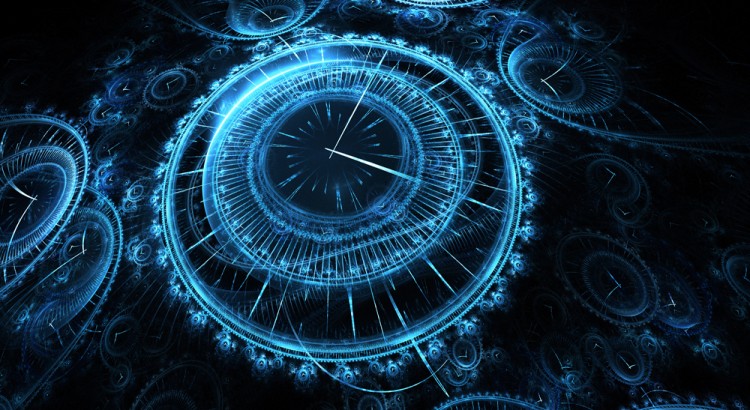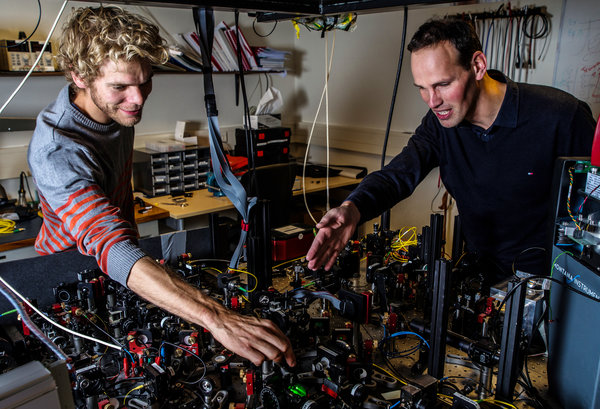 Μελέτη που δημοσιεύεται στο κορυφαίο περιοδικό Nature (Φύση) αναφέρει πώς δύο ηλεκτρόνια που απείχαν 1,3 χιλιόμετρα σε διαφορετικά εργαστήρια του Πανεπιστημίου της Ντελφτ συμπεριφέρονταν σαν να ήταν συνεννοημένα από πριν.
Μελέτη που δημοσιεύεται στο κορυφαίο περιοδικό Nature (Φύση) αναφέρει πώς δύο ηλεκτρόνια που απείχαν 1,3 χιλιόμετρα σε διαφορετικά εργαστήρια του Πανεπιστημίου της Ντελφτ συμπεριφέρονταν σαν να ήταν συνεννοημένα από πριν.
Στον παράξενο κόσμο της κβαντομηχανικής, με την οποία ο Αϊνστάιν ουδέποτε κατάφερε να συμφιλιωθεί, προβλέπει ότι ένα σωματίδιο μπορεί να βρίσκεται σε διαφορετικές θέσεις ταυτόχρονα, και «κλειδώνει» τελικά σε μια συγκεκριμένη θέση, μόνο αν κάποιος μπει στον κόπο να το παρατηρήσει. Η κβαντική θεωρία προβλέπει επίσης ότι δύο ή περισσότερα σωματίδια μπορούν κάτω από ορισμένες συνθήκες να διεμπλακούν: αυτό σημαίνει ότι οποιαδήποτε μεταβολή στο ένα από τα συνδεδεμένα σωματίδια προκαλεί αντίστοιχες, ακαριαίες μεταβολές και στα υπόλοιπα συνδεδεμένα σωματίδια.
Όπως εξηγούσε σε ένα διαβόητο άρθρο του το 1935, ο Αϊνστάιν απέρριπτε την ιδέα της κβαντικής διεμπλοκής, για την οποία χρησιμοποιούσε τον αφοριστικό χαρακτηρισμό «απόκοσμη δράση από απόσταση» (spooky action at a distance). Περισσότερο τον ενοχλούσε η ιδέα της ακαριαίας αλληλεπίδρασης από μεγάλες αποστάσεις, μια ιδέα που έδειχνε να έρχεται σε αντίθεση με τη βεβαιότητα ότι τίποτα δεν ταξιδεύει ταχύτερα από το φως; Πώς θα ήταν δυνατόν ένα σωματίδιο να ενημερώνει ακαριαία το απομακρυσμένο αδελφάκι του ότι κάτι έχει αλλάξει;

Ο Bas Hensen, αριστερά και o Ronald Hanson δεξιά, απέδειξαν ότι τα αντικείμενα μπορούν να επηρεάσουν ακαριαία το ένα το άλλο. Φωτογραφία: Frank Auperle/Τεχνολογικό Πανεπιστήμιο του Delft.
Ο «Πατέρας της Σχετικότητας» πίστευε ότι τα σωματίδια έχουν άγνωστες ιδιότητες, οι οποίες με κάποιο τρόπο μας ξεγελούν ώστε να νομίζουμε ότι η αλληλεπίδραση είναι ακαριαία, ενώ στην πραγματικότητα είναι προαποφασισμένη. Κι όμως, πολυάριθμα πειράματα τις τελευταίες δεκαετίες έχουν διαψεύσει τον Αϊνστάιν. Το πρόβλημα όμως ήταν ότι υπήρχαν δύο θεωρητικά «παραθυράκια», τα οποία καθιστούσαν αδύνατη την οριστική απόδειξη της κβαντικής εμπλοκής.
Το πρώτο παραθυράκι αφορά το γεγονός ότι μόνο ένα μέρος των σωματιδίων του πειράματος είναι δυνατό να ανιχνευθούν–οι ερευνητές πρέπει επομένως να αρκούνται στην υπόθεση ότι τα σωματίδια που ανίχνευσαν είναι ενδεικτικά του συνόλου, κάτι που δεν ισχύει απαραίτητα στον παράξενο κόσμο της κβαντομηχανικής.
Για να λύσουν το πρόβλημα, πολλές ερευνητικές ομάδες δεν χρησιμοποίησαν υποατομικά σωματίδια αλλά ολόκληρα άτομα, τα οποία είναι πιο εύκολο να ανιχνευθούν. Αυτό όμως ανοίγει ένα δεύτερο παραθυράκι, καθώς είναι δύσκολο να διατηρήσει κανείς τη διεμπλοκή ατόμων τα οποία απέχουν μεγάλες αποστάσεις μεταξύ τους. Αν όμως η απόσταση του πειράματος είναι μικρή, τότε το ένα σωματίδιο μπορεί θεωρητικά να ενημερώσει το άλλο χωρίς να παραβιαστεί η ταχύτητα του φωτός.
Η νέα μελέτη κλείνει τα δύο παραθυράκια και δείχνει να βάζει το τελευταίο καρφί στο φέρετρο του Αϊνστάιν. Ο Ρόναλντ Χάνσον και οι συνεργάτες του ακολούθησαν με μια ιδιοφυή προσέγγιση, στην οποία δύο ηλεκτρόνια συνδέθηκαν με δύο φωτόνια τα οποία στη συνέχεια συνδέθηκαν μεταξύ τους. Αυτό τελικά δημιούργησε διεμπλοκή ανάμεσα στα δύο ηλεκτρόνια από απόσταση 1,3 χιλιομέτρων. Για τεχνικούς λόγους, η μεθοδολογία αυτή αποκλείει τα δύο παραθυράκια και δείχνει να τερματίζει, τελεσίδικα, μια επιστημονική διαμάχη 80 ετών.




